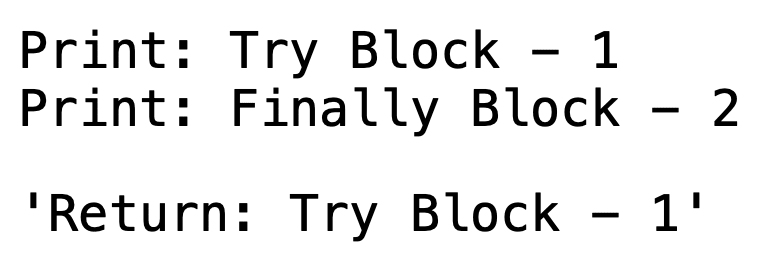In python, try and except blocks are often used by programmers for handling any exception or unhappy scenarios. finally clause is very under appreciated & can be better utilized. Let us check out how final-block works.
Deep dive
No matter what happened previously, the final-block is executed once the code block is complete and any raised exceptions handled. Even if there's an error in an exception handler or the else-block and a new exception is raised, the code in the final-block is still run.
This quote from the python documentation is absolutely correct but the execution behavior is little tricky when try and finally blocks are encapsulated within a function which has a return statement. Let me explain with examples. See if you could guess the output of the following functions.
Example 1:
# Both the try & final blocks have print statements and function returns value from final-block
def example_1():
try:
val = 1
print(f"Print: Try Block - {val}")
finally:
val = val + 1
print(f"Print: Finally Block - {val}")
return f"Return: Finally Block - {val}"
example_1()
Function example_1 is simple and straight, first the try-block gets executed and then final-block. The variable val has value 1 in try-block and gets updated to 2 in final-block.
Example 2
# The try block has return statement & final block has only print statement
def example_2():
try:
val = 1
print(f"Print: Try Block - {val}")
return f"Return: Try Block - {val}"
finally:
val = val + 1
print(f"Print: Finally Block - {val}")
example_2()
Function example_2 is where things get a bit tricky, the return statement in try-block is executed after the final-block but the value of the variable val returned is not affected by the changes made in the final-block.
Example 3
# Both the try & final blocks have return statements
def example_3():
try:
val = 1
print(f"Print: Try Block - {val}")
return f"Return: Try Block - {val}"
finally:
val = val + 1
print(f"Print: Finally Block - {val}")
return f"Return: Finally Block - {val}"
example_3()
Output of the function example_3 is easy to guess. When the return statement in final-block is executed, the function exits so the return statement in try-block is never executed.
Take Away
try & finally blocks are not quite as straight forward as one might think, especially when they are returning values from a function. For more such interesting tidbits follow me via Twitter. The takeaways from this post are:
- Where you put the
returnstatement is going to make a difference. - Even though the
returnstatement from try-block is executed after the final-block, value of the variable returned won't be affected by alteration made in the final-block.











Top comments (0)